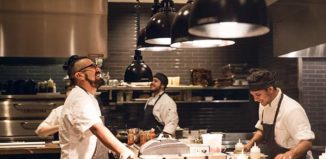When most people think about the cocktails of New Orleans, they conjure images of Pat O’briens Hurricanes and Daiquiris in foot-long plastic tubes. The fun-filled party drinks certainly occupy a big part of New Orleans ’s bibulous culture. However, there is another big easy bar culture that not only stretches back to the very beginning of cocktail history, but also has become one of the epicenters of the modern cocktail revival.
Though some New Orleaneans claim their hometown as the birthplace of the cocktail, most available evidence points to an east Coast nativity. However, the importance of New Orleans to cocktail culture is without question. If cocktail mixology is to be considered as a culinary art, it is fitting that it has an established home in one of America’s richest culinary cities. With numerous grand old hotels and restaurants, many more than 100 years old, New Orleans can claim not just longevity, but a continuity that is not found in most cities. There are a lot of older cities that once had a cocktail culture but lost it along the way. Cocktail culture has persisted in New Orleans, like many of the city’s idiosyncrasies. The general conviviality of New Orleans culture has no doubt influenced its cocktail artistry. It is one of the only places in the country where walking down the street with an alcoholic beverage is not just legal, but practically encouraged. It is also the only place where the morning “eye opener” is viewed as part of polite social interaction and not degenerate alcoholism.
Ann Tuennerman is not a bartender by trade but has done as much as any drink-slinger to promote the craft. She is the founder of tales of the Cocktail, an annual cocktail and culinary festival held each year in New Orleans. Now in its eighth year, the festival has grown to host many dozens of events for thousands of participants each year. Tuennerman started her career in cocktails by organizing a walking tour of historic New Orleans bars and restaurants. Her entrepreneurial spirit led her to start a cocktail festival that has grown to be one of the most prestigious such events in the world, each year attracting the top luminaries in the field to the Crescent City.
If there is any cocktail with which to start a conversation about New Orleans drinks, it is the Sazerac. The Sazerac is a cocktail of comparatively ancient provenance that has maintained a nearly constant popularity in New Orleans since the 1830s. Its progenitor was Antoine Amedee Peychaud, who owned an apothecary shop and began concocting proprietary bitters, which were, at the time, taken primarily for (pseudo-) medicinal purposes. Eventually, he mixed his bitters with Cognac into a sort of toddy, and the resulting Saz erac cocktail became a main- stay of New Orleans tippling.
The Modern Day Sazerac – consisting of rye whiskey, sugar, Herbsaint (an absinthe-like spirit native to New Orleans) and Peychaud’s Bitters – very closely follows the earliest known definition of the word “cocktail” as it relates to recreational drinking.
“The Sazerac has been a constant in New Orleans,” according to Tuennerman. “It never got too trendy or fell from grace.”
Tuennerman is a self- proclaimed “Sazeractivist” and led the charge last year for the Louisiana Legislature to proclaim the Sazerac “the official cocktail of New Orleans.”
The Vieux Carré (literally the “old square,” a nickname for the French Quarter) was invented in New Orleans at the Hotel Monteleone, home to the magnificent Carousel Lounge. It first appears in the 1937 edition of Stanely Clisby Arther’s “Famous New Orleans Drinks and How to Mix ’Em,” and is attributed to Monteleone barman Walter Bergeron.
The French 75 has a long association with New Orleans , although it most likely was not invented there. Nearly everywhere else in the world, the cocktail consists of gin, lemon juice, sugar and Champagne. In New Orleans, specifically at Arnaud’s French 75 Bar, the gin is replaced by Cognac, a nod to the city’s French heritage.
Absinthe was popular in turn-of-the-20th-century France so was, in turn, popular in New Orleans. The Old Absinthe House on Bourbon Street has been there since the 1870s, though for most of the last century true Absinthe was illegal in the United States. Absinthe is once again on the market and behind the bar, and the Absinthe Frappé is a delicious and classic way to drink it.
The Ramos Gin Fizz is one of the greatest cocktails to originate from New Orleans. It dates to the late 1880s at the Imperial Cabinet Bar of Henry C. Ramos (pronounced Ray-mos.) The drink took off so well that when Ramos brought his fizz to the Stag Saloon in the early 1900s, demand was so high that he employed literally dozens of bartenders in the manufacture of his famous fizz.
According to Stanley Clisby Arther, “The corps of busy shaker boys behind the bar was one of the sights of the town during Carnival, and in the 1915 Mardi Gras, 35 shaker boys nearly shook their arms off, but were still unable to keep up with the demand.”
In his “Gentleman’s Companion,” which came out in 1939, Charles H. Baker Jr. writes that, “The Ramos Fizz has long been synonymous with the finest of the New Orleans art. Thinking that the formula, like any history dealing with the dead arts, should be engraved on the tablets of history, it was given to the world after the now rejuvenated Ramos bar closed for the ‘dry’ era [Prohibition].”
Despite the tragedy that was Prohibition, we are thankful that the brothers Ramos were so generous as to share their recipe with posterity.
French 75
11⁄2 oz Gin or Cognac
1⁄2 oz Fresh-squeezed lemon juice
1⁄2 oz simple syrup
Champagne or sparkling wine
Combine first three ingredients in a mixing glass. Shake with ice to chill & strain into a chilled champagne flute. Top with Champagne and garnish with a lemon twist. This cocktail is also traditionally served over cracked ice in a Collins glass.
Vieux Carre’
1 oz Cognac
1 oz Rye whiskey
1 oz Sweet Vermouth
Barspoon Benedictine
Dash Peychaud’s bitters
Dash Angostura bitters
Combine ingredients in a cocktail glass and stir to chill. Strain into a chilled cocktail glass, garnish with a lemon twist
Sazerac
2 oz Rye whiskey
Scant 1⁄2 oz simple syrup
4 dashes Peychaud’s bitters
1/4 oz Pernod, Herbsaint or Absinthe
Fill one rocks glass with ice and water to chill.
In a mixing glass combine rye, simple syrup and Peychaud’s bitters. Stir thoroughly with ice to chill. Dump the ice water from rocks glass and add Pernod or Herbsaint, spinning the glass in your hand to coat the sides with the spirit. Dump excess and strain cocktail into the “seasoned” rocks glass. Serve the cocktail “up” (without ice), garnished with a lemon twist.
Absinthe Frappé
11⁄2 oz Absinthe
Scant 1⁄2 oz simple syrup
Club soda
Build over cracked ice in a coupe or small rocks glass. Spritz with club soda. Serve with small sipper straws.
Ramos Gin Fizz
11⁄2 oz Gin
1⁄2 oz fresh-squeezed lemon juice
1⁄2 oz fresh-squeezed lime juice
1 oz simple syrup
1 oz egg white
2 oz heavy cream
2 drops orange flower water
Club soda
Combine ingredients in a mixing glass. Add ice and shake very vigorously – for at least one minute and up to several minutes. The goal is to achieve a “ropey” consistency, which requires a very long shake. When the cocktail has been shaken long enough, the shaker begins to emit a thumping sound when you tap it. Strain the cocktail into a Collins glass with no ice. Top with a spritz of club soda, about 1-2 oz. (Note: orange flower water is available at Middle Eastern groceries and higher-end supermarkets. There is no substitution for orange flower water in this drink.)



































